Perennial eustoma: description, planting and care
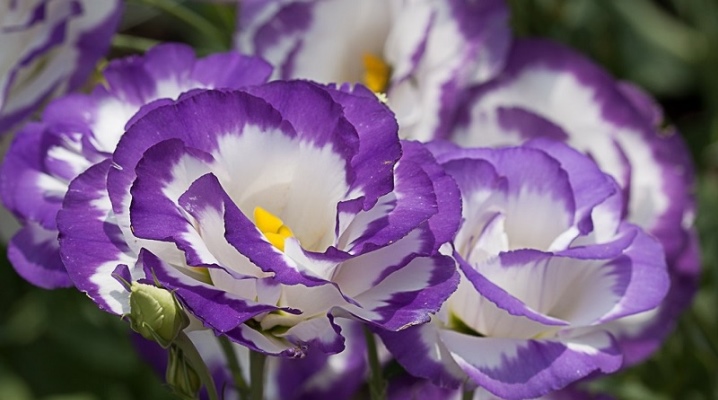
Eustoma (lisianthus) is a perennial, ornamental plant whose flowers resemble not only roses, but also poppies and mallow. Due to its beauty, the flower can become a highlight of any garden. But beginner gardeners should first familiarize themselves with the description of the plant, find out how planting and care is carried out correctly.
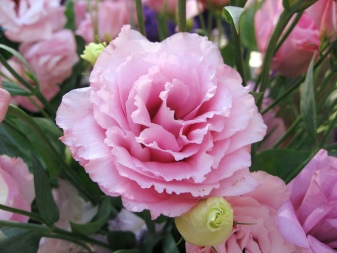
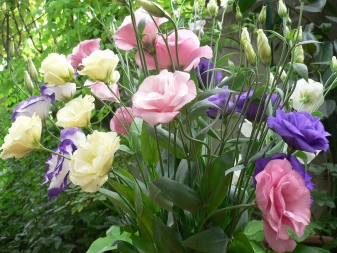
Peculiarities
Lisianthus translated from Latin means "bitter flower". Eustoma belongs to the gentian family. Due to the variety of shades, it is in great demand among florists. In our latitude, the cultivation of perennial eustoma is a rather complicated process, so it can be grown as an annual or biennial.
Its homeland is countries with warm and humid climates. In the wild, the plant grows in subtropical regions such as South America, Mexico, and the Caribbean. In different areas, its name sounds different: "prairie flower", "Texas bell", "Irish rose".

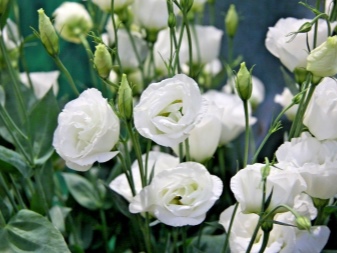
Eustoma is a gorgeous plant, distinguished by large, beautiful flowers, the diameter of which can reach 8 cm. Tall varieties grow up to 1.2 m. In the middle of the stem, it branches out, and then the buds ripen. There can be about 35 flowers on one shoot, so it looks like a ready-made bouquet. Most often, the buds bloom in a certain sequence, sometimes they all open at the same time. Wild lisianthus has deep blue flowers. And the already bred hybrid varieties are distinguished by the vivid colors: white, lavender, pink, combined with multi-colored edging.
The leaves are green with a bluish tinge, have an oval shape and are located on the stem without thorns in two rows. The flower has a very branchy, fibrous rhizome with fragile roots. Thin roots are located in the upper layer of the earth and are almost not buried. From the flower, picturesque flower arrangements are created, which are much more popular than bouquets of roses. A bouquet of lisianthus can stand in a vase for about three weeks. A perennial can only be grown indoors, and an annual outdoors.
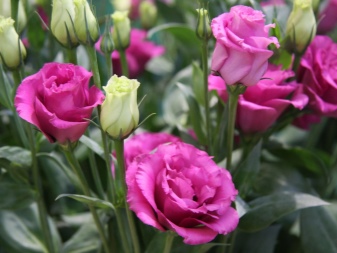
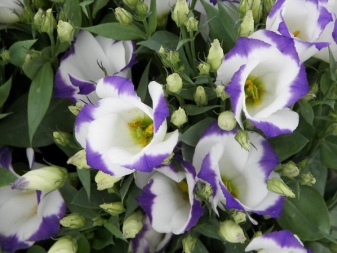
Differences from annual flowers
Since a perennial can only be grown in a subtropical climate, its growth can reach 15-20 cm.An annual can grow in outdoor conditions and reaches a height of up to 1.2 m. Perennial eustoma requires a lot of experience as a gardener, and the cultivation of annual varieties is within the power of even the most novice flower lover.
Long-term cultivation is possible only indoors.
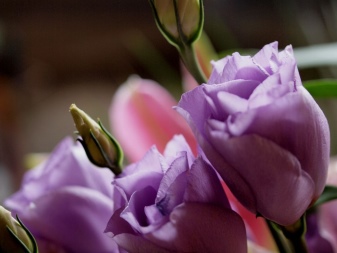
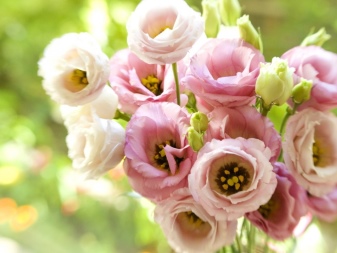
Types and varieties
There are three types of perennial eustoma. Large-flowered is the most popular species among gardeners, used for planting in the garden or in greenhouses for cutting. The species is about 1.5 meters high. Petals are located throughout the stem, and branching goes to the top. The oval-shaped leaves have a rich green tint. Inflorescences are large, collected on one stem, tightly pressed to each other. Flowers with delicate petals differ in shade and structural features, depending on the variety. There are about 60 varieties of eustoma. The most common ones are presented below.
- Florida Pink Is a perennial garden variety. It attracts attention with large, profusely blooming pink inflorescences.
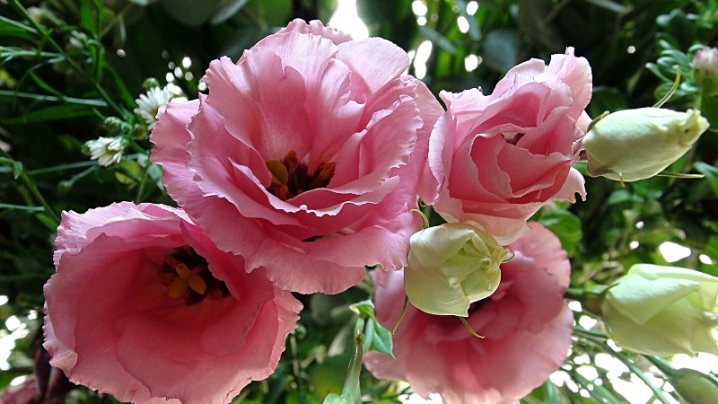
- "White large-flowered" (Lisianthus grandiflorum). Differs in lush, dense white bloom.Has many flowers on one stem, creates the appearance of a luxurious bouquet. Such compositions are used to decorate banquets and weddings.

The tall species includes varieties with a height of 70 cm to 1.5 m.
- Aurora - an early flowering variety, reaches a height of about 1.2 m. Beautiful double flowers have bright purple, blue or white shades.
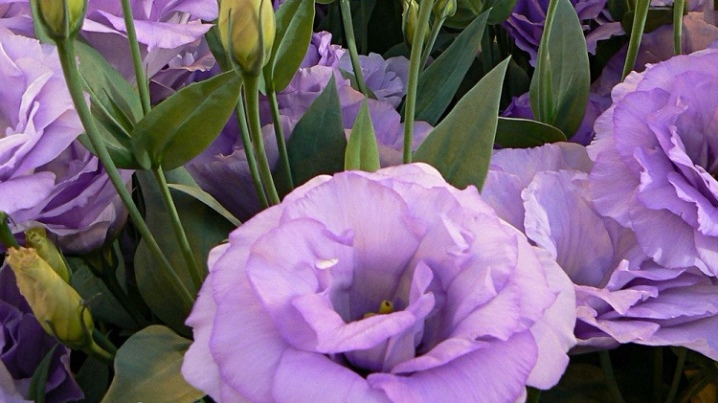
- Flamenco - an unpretentious species, distinguished by its colorful flowers on a large number of buds. Reaches a height of up to 1.3 meters.
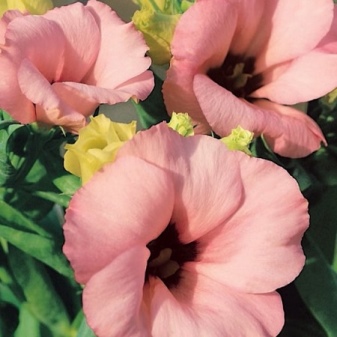
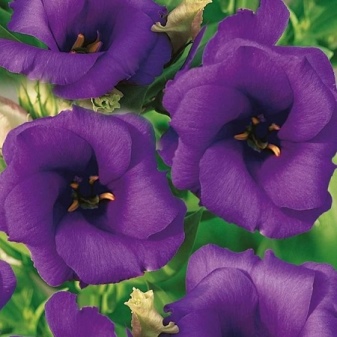
- "Mariachi lime" differs in double, lush flowers of light green color.
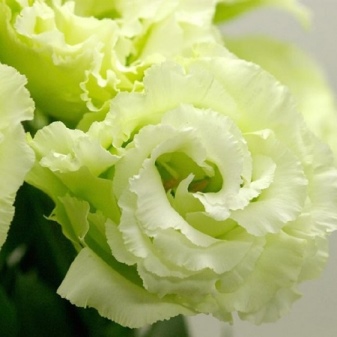
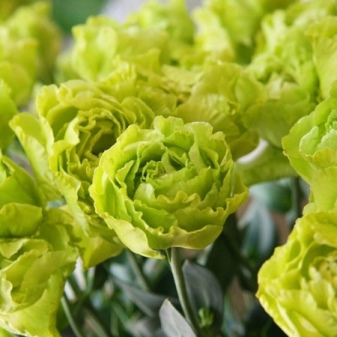
- Beppin-san - an exquisite variety, has unusual petals on flowers. They are carved at the edges, airy, like the feathers of a bird, of an unusual color. It can be pale milky and pink with a light green center.

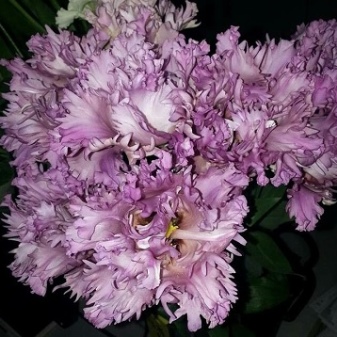
- Heidi - a popular variety because of the variety of its shades, and there are about 15 of them. Reaches a height of up to one meter. The inflorescences are located separately from each other, distinguished by thin large petals. The flowers have a bright red hue.
This variety is suitable for planting in the garden and indoors.

- Russell has a beautiful, compact shape. The stems are branched, the leaves are oval and gray in color. The flowers of the plant are very large, like bells. The color palette is diverse, there are white, blue, lilac, pink specimens. There are two colors that combine in themselves. This variety is very popular with gardeners.
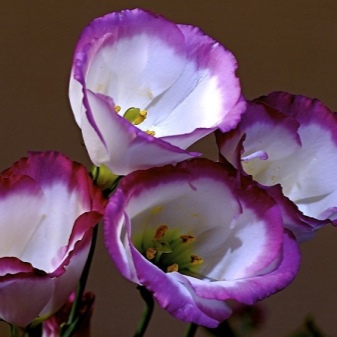
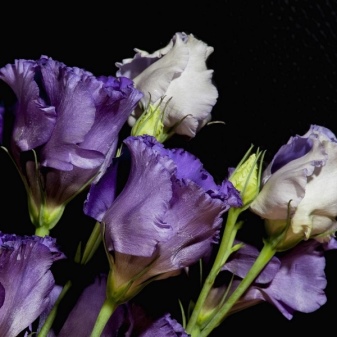
- Flamenco yellow - An unpretentious cultivar to care for, reaches a height of 70 cm. It has large yellow flowers, which are spiral-shaped on the shoot. The flower exudes a pleasant aroma. Has early flowering. The flower reaches 7 centimeters in diameter.
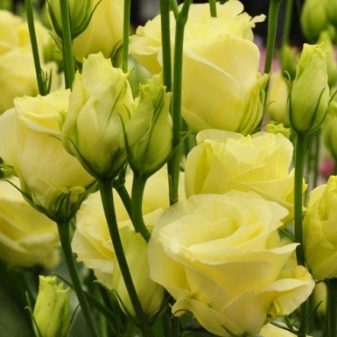
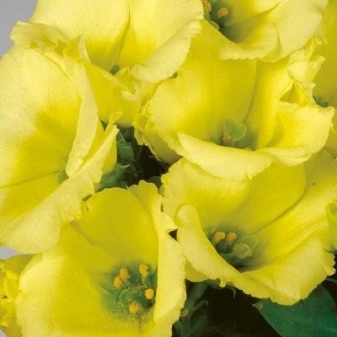
The undersized species includes varieties with a height of 12 to 20 cm.
- "Sapphire pink haze" reaches a maximum height of 10-15 cm. The leaf plate has a glossy surface and a bluish tint. Large flowers of a white-pink hue have a funnel-shaped shape.

- "Riddle F1" - the plant has an incredibly beautiful, compact bush about 20 cm high. The flowers are multi-layered, light blue in color, the structure resembles a rose. The petals have a satin surface. Flowers are located oppositely on the shoot. Eustoma is adapted to grow indoors and outdoors.
For the appearance of flowering in July, they try to carry out planting no later than the beginning of March.
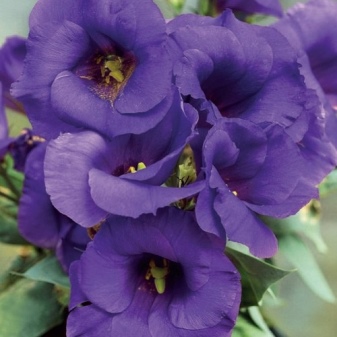
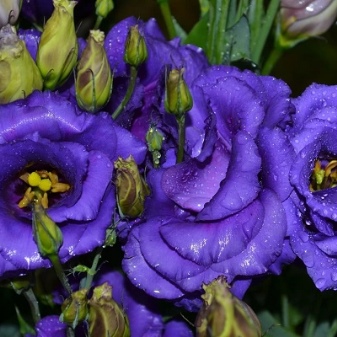
- "F1 Loyalty" differs in small growth, up to 20 cm. A large number of small white flowers are arranged in a spiral.

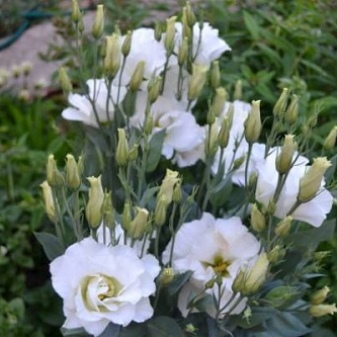
- Echo reaches a maximum height of 60 cm. Thanks to flowers of different shades, and there are about 11 of them, both monochromatic and with a smooth transition from one color to another, it is widely used in the preparation of bouquet compositions.
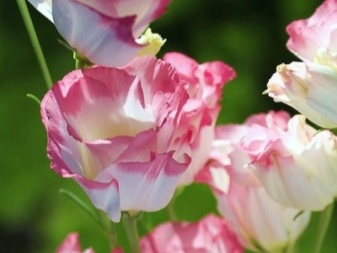
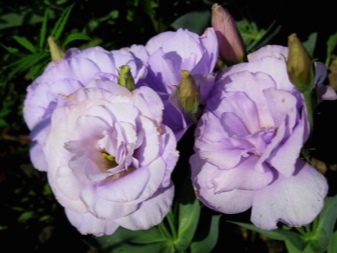
- "Mermaid" (Mermeid) - dwarf species, reaching only 15 cm. Used for growing in pots. Has a gorgeous terry bloom in blue and pink tones, as well as in white and milky shades.
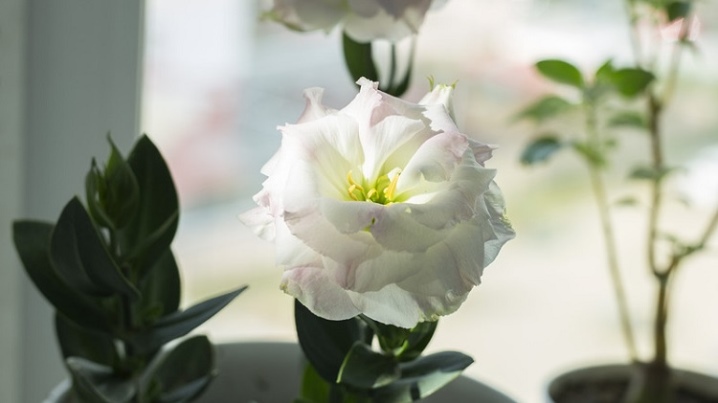
- Little Bell - seemingly a very simple flower, but in composition with other magnificent brothers it looks very strict and unique. Differs in lilac bloom. Suitable for growing in pots.
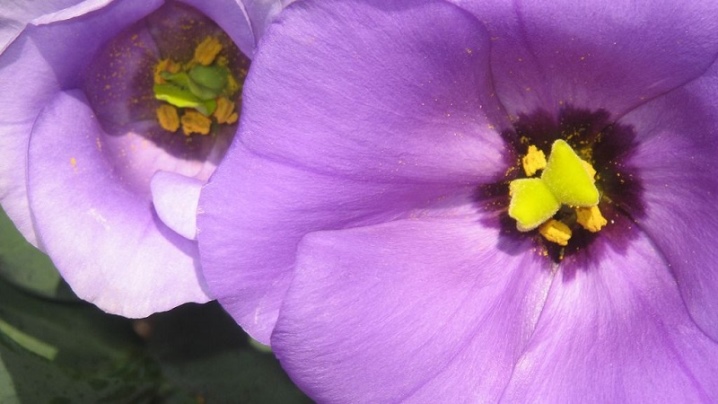
Growing conditions
In order for flowers to always please the eye and develop correctly, they need full care and optimal conditions for keeping.
Temperature and lighting
Since lisianthus is a tropical flower, it requires a lot of light and growing in warm conditions. During the day, the temperature should be 20-25 C, and at night at least 15 C. Only in the presence of such factors will the plant bloom well.
If the nights are cold and there is little light, the bloom will be very poor.

The soil
The soil plays a big role in the life of the plant. It must be fertile, containing mineral fertilizers and compost. A lot of microelements are spent on the ripening of buds, so if there are enough of them in the soil, then flowering will be developed. The ideal would be the ratio of one part of peat to one part of black soil or humus. The soil should always be moist, but not excessively, with good drainage. For planting, a place on a hill is often chosen to prevent stagnation of moisture, because this can lead to root rot and death of the plant. The appearance of yellow leaves on a shrub may indicate an increased acidity in the soil. You can remove it by adding lime flour.

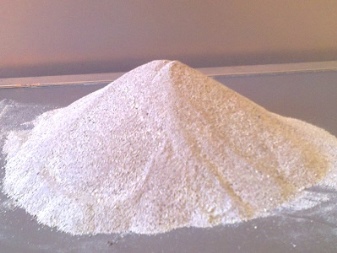
How to plant?
After you have selected the appropriate place for planting eustoma, and it should be free of drafts and wind, choose a cloudy day, in the late afternoon. It is necessary to land in late spring or early summer, when the nights are warm and the earth is warmed up. Before planting a seedling from a container into open ground, prepare a depression in the ground, no larger than the pot in which the seedling was located. Gently remove the seedling from the pot, just turn it upside down so that, without damaging the root system, immediately plant it in a hole in the place with a clod of earth. Sprinkle lightly with earth and cover with a transparent hood to avoid drafts and sudden drops in temperature.
A gap of 20-25 cm is recommended between seedlings. It does not matter how the plant is planted, in the form of a seed or a seedling, it will still bloom in the first year. Flowering lasts about two months, from mid-summer to autumn. At this time, you can periodically cut the stems with flowers, since new ones will grow during the abundant flowering anyway. The plant should not be planted near metal fences, because when they are heated from the sun, the flower can get burned.

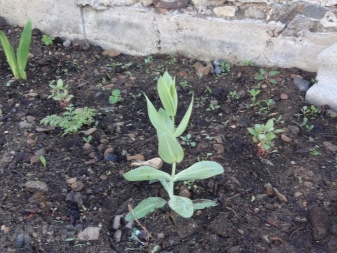
How to take care of it properly?
There are no particular difficulties in caring for this plant. But, nevertheless, it needs timely watering, feeding, protection from diseases and pests.
Watering
The plant categorically does not tolerate stagnant moisture and periods of drought. Lisianthus sheds buds from drying out of the soil. It will be optimal to maintain moderate humidity; it is necessary to irrigate as the top layer of the earth dries up with rain or settled water.
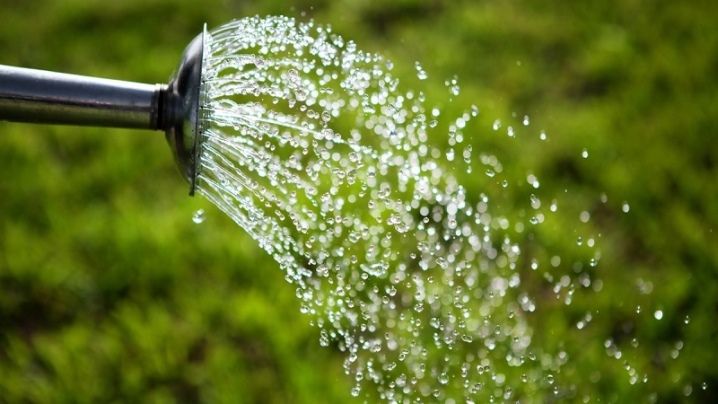
Fertilizer
Since the flowering of eustema begins in mid-summer, it is during this period that it is necessary to feed the plant with fertilizers. They should have a high content of potassium and phosphorus, a small amount of nitrogen. The most suitable for this are the preparations "Plantafol budding", "Kemira lux". They have a beneficial effect on flowering, making it luxurious and long-lasting. The only rule: the concentration of the fertilizing prescribed in the instructions should be slightly less.
After the end of flowering, it is necessary to carry out a second procedure with mineral fertilizers. Organic food, mullein infusion, chicken droppings, or wood ash are also suitable.

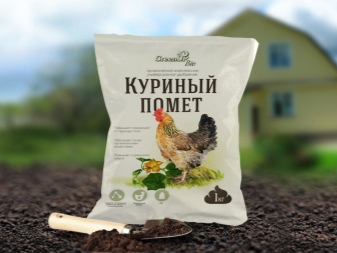
Pruning
Pruning faded inflorescences is not only a prerequisite for maintaining decorativeness, but also a measure to stimulate the growth of new flowers. Do not be afraid to cut off shoots to compose a bouquet, new ones will ripen in about a month.
Pinching is important for the plant. It is carried out between 3-4 pairs of leaves. Thanks to this, they grow, the flowers become lush, their number increases to 20 pieces.
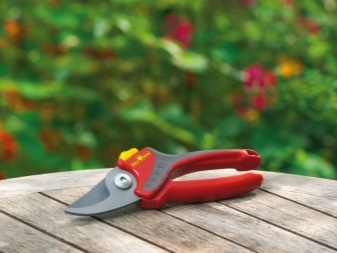
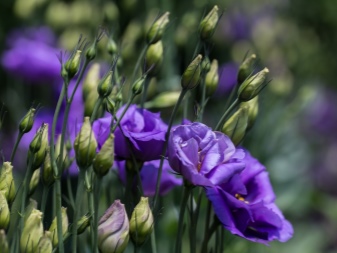
Seed collection and wintering
After the end of flowering, seed pods are formed. They ripen only after pollination of the inflorescence. If the plant is on the street, then the bees are engaged in this, and if the flower lives in the house, then pollination can be done with a brush. The seeds are harvested in dry weather, when there has been no rain for more than a week. The collected seeds have good germination. They are well dried in room conditions and stored until spring.
After collecting the seeds, the plant can be prepared for winter. Around September, when the weather is still warm, the stems of the plant are cut, leaving only 3-4 buds, and transplanted into a pot.The flower does not tolerate a transplant, it needs adaptation, it is at this time that additional care must be provided to the plant. The pot is transferred to a room where the temperature should be 10-15 degrees. Provide a gradual decrease in illumination, maintain the humidity in the room. Watering is gradually reduced to a minimum, moisturizing is carried out every 10-14 days. While the plant hibernates, it is dormant and does not grow, its vital functions slow down. Due to frequent transplants, he lives in our latitudes for no more than 5 years. Every year and with every transplant, the flowering is not so abundant, the size of the flowers decreases.
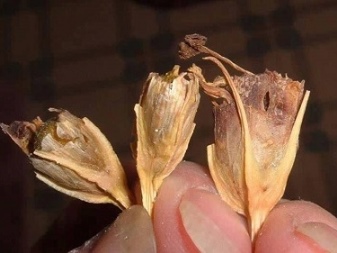
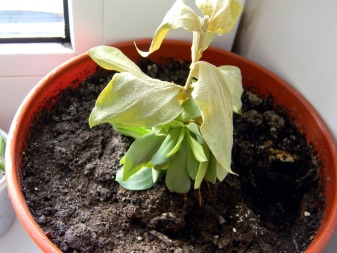
Reproduction methods
The seed method is the most popular for flower propagation. The best time to plant seeds is between November and February. Choose sowing on the growing moon. Prepare a container of earth. You can buy ready-made soil, intended for violets, or make a nutrient mixture yourself. For self-cooking, you can mix peat with garden soil, add some sand and wood ash.
The soil must be disinfected. For this, the soil is steamed over a water bath. This procedure takes about 45-60 minutes. Of course, after this method, the earth becomes empty, without useful minerals, but completely sterile. Fitosporin or Baikal M1 will help to replenish useful elements. Containers or other containers must also be sterilized.


It is better to sow seeds in separate peat pots, in the future this will ensure a painless planting in the ground. There must be drainage at the bottom. The seeds are fine, so use a toothbrush for easy planting. Optimally, each pot should contain no more than 4 seeds. Spray the top layer with water using a spray gun and gently, pressing a little, plant the planting material.
Do not cover the earth to the very edge of the glass, leave 2 cm free, without soil. The temperature in the room where the young seedlings are located should be 20-21 C during the day, and at least 15 C at night. To ensure the greenhouse effect, cover the containers with glass or foil. Seed germination rate is 60 percent. The first shoots usually appear in 10-14 days. They require good lighting, without direct sunlight.
If you don't have a lot of bright spots in your house, use lighting with a lamp. Greenhouse devices begin to open slightly to harden the plant.



First, this is done for 10 minutes a day, then for half an hour, then they are removed altogether. Watering is carried out using a sprayer, as the top layer dries. It is recommended to use water that is separated and at room temperature. The air in the room must be humidified; for this it is good to use electric humidifiers. In March, the flower will gain about 20 cm in height, it will already have a couple of leaves, it is transplanted by transferring it to a permanent place of growth. Flowering begins 20 weeks after sowing.
Some gardeners breed lisianthus with cuttings. This, of course, is an easier method compared to seed, but the survival rate is much lower. To do this, take the flower for the winter and keep it in a cool room. Around the end of January or the beginning of February, shoots begin to appear on the cut branches. They are carefully separated from the mother plant and placed in the Kornevin stimulating solution. After 2-3 weeks, the cuttings will take root, they can be transplanted into a separate glass, preferably from peat. A small drainage is laid at the bottom and covered with special soil for violets. It is moistened and a glass with a seedling is placed on the window. After ten days, feed the young seedlings with nitrogen. At dusk, the seedlings are additionally illuminated.
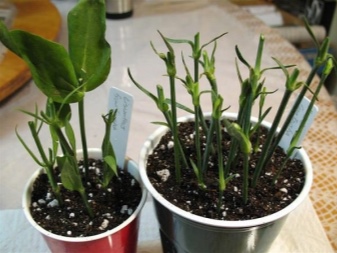

Diseases and pests
With proper care, the plant is not susceptible to disease and parasite attack. During the season of heavy rains, accompanied by coolness, the level of moisture in the soil increases. With an excess and stagnation of moisture, the plant is affected by gray rot, powdery mildew, fusarium. It is quite difficult to cure gray rot, since the root is in a humid environment. Better to dispose of the flower. Antifungal drugs are used to disinfect and treat other diseases.
When a whitefly or aphid attacks a flower, the eustoma is sprayed with Aktara or Prestige. Perennial eustoma is a wonderful decoration for a garden or home.
Of course, this is not the easiest flower to care for, but if you follow all the rules for content, its beauty will pay off all your efforts.
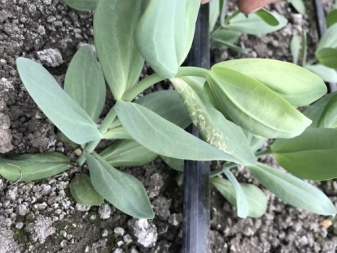
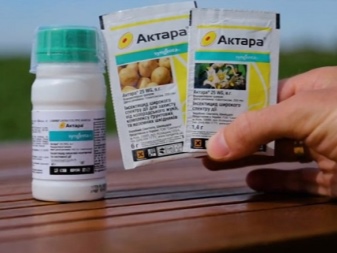
In the next video, you will find additional information on the types and varieties of eustoma.






































































































The comment was sent successfully.